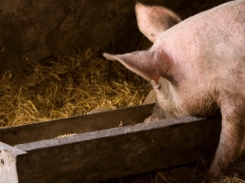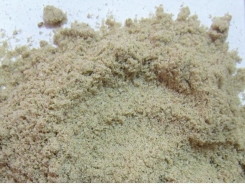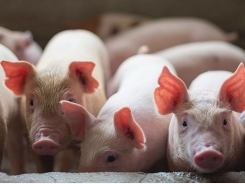Nine protein alternatives for pig feeds

Courtesy of Masham Micronized Feeds | Beans, before and after micronization -- processing of legumes improves quality, but also increases their price.
Is it possible to reduce our reliance on soya with alternative protein sources, each with their own benefits and limitations?
Transporting raw materials, like soya, from South America and the destruction of ecosystems there have a significant environmental impact. Similar concerns are raised for fishmeal, along with price and consistency of supply. Food security is high on the agenda of many governments, as is improving agricultural sustainability. So what if protein could be produced closer to home, in a sustainable and economic manner?
This article will cover nine alternative protein sources that can be used in pig diets. Some, such as sunflower, canola and dried distillers grains with solubles (DDGS), could feature more regularly in rations. Peas, beans and lupins are used in some regions but could be grown more widely. Commercialization of products like insect meal, Lenma protein concentrate and algae, is on-going but has the potential to supply high-quality protein for pigs.
Sunflower meal
Sunflowers are primarily grown for their oil content; following its extraction, the remaining meal is used in pig diets. The protein content varies from 23 percent in the whole seeds to up to 40 percent in a de-hulled solvent extracted meal. When prices are favorable, sunflower meal is included in diets up to 20 percent, where 50 percent of soya is replaced, and has been shown to be cost effective. However, digestibility of the protein is an issue along with the presence of phenolic compounds. This is why it isn’t recommended for young pigs.
Canola meal
The product mainly fed to livestock is a co-product of oil extraction and contains 41-43 percent protein. Canola (oil seed rape) can be grown in colder climates than sunflowers, making it a viable choice for more growers. Anti-nutritional factors (ANFs) are an issue, but breeding programs have developed cultivars with low-glucosinolate levels and reduced amounts of erucic acid. A 5 percent inclusion limit for nursery diets is often quoted, but levels up to 25 percent for grow-finish pigs do not affect performance.
DDGS
DDGS is a co-product from the alcohol and biofuel industries derived from corn or wheat. With protein levels of 30-40 percent, DDGS has the potential to replace a proportion of soya in pig diets. However, finding a consistent source of DDGS is a challenge. Variable quality and the potential for mycotoxin contamination mean that formulators are still cautious. Further information on amino acid digestibilities and inclusion levels for pigs will ascertain the true value of DDGS. Currently recommendations are from 20 percent for growing animals to up to 50 percent for adult pigs.
Copra meal
Copra meal is derived from coconut meat, following oil extraction, and has high oil and protein (20-25 percent) levels. Primary production is in Asia, where it is a low-cost ingredient. However, it is high in fiber and low in essential amino acids. These factors, along with the presence of mannan and glactomannan, limit its inclusion to 5-25 percent, increasing with the age of the animal.
Peas and beans
There are many varieties of peas and beans grown around the world, suited to different climates: from broad beans in Europe to chickpeas in Asia. They are a promising alternative to soya in regions that are not suited to its production. Peas have high levels of protein (25 percent) and essential amino acids, although methionine levels are relatively low. Legumes are a useful part of any crop rotation due to their ability to fix nitrogen. In terms of ANFs, peas contain protease inhibitors, lectines and phytate, whilst beans have high tannin and alkaloid levels. Both benefit from further processing, micronization, for example, which allows greater inclusion levels.
Lupins
Lupins are also a leguminous plant but with a higher protein content (35 percent). Low-alkaloid varieties are most suitable for monogastric nutrition, differing from the white-type lupins grown as a fodder crop for ruminants. Lupins have a thick, fibrous seed coat; mechanical removal of which increases the protein content further. There has been a resurgence of interest in growing lupins in Europe, as their nutritional profile is comparable with soya. Australia has considerable experience feeding this crop to livestock, being the largest producer. Trials suggest lupins can be used in pig diets from between 10 and 30 percent depending on the age and stage of the animals.
Insect meal
Insect species currently being researched are the black soldier fly (Hermetica illucens), common housefly (Musca domestica) and yellow mealworm (Tenebrio molitor). Large-scale production processes are being developed by several companies, and further feeding trials are planned. Organic waste is used as a nutrient source and the larvae harvested. These contain between 30 and 70 percent protein, from which a dry meal is produced. The levels of amino acids supplied were found to be more than is required for growing pigs, and digestbilities appear good.
Lemna
Lemna, commonly known as duckweed, has been traditionally used as an animal feedstuff in many parts of the world. It is a rapidly growing aquatic plant, with a very high protein content (35-45 percent). Commercially it is cultivated in large growth systems, then harvested and dried. Further processing increases the protein concentration, ensuring a reliable and consistent product.
An experiment determined the digestibility of Lemna Protein Concentrate (LPC) in weanling pigs. Researchers concluded that the crude protein and amino acids were well digested, with mean standard Ileal digestibility (SID) values of 79.09 and 81.70 percent, respectively. LPC contained a greater concentration of SID protein and amino acids compared with soybean meal, and similar amounts to fishmeal.
Algae
Algae are the fastest growing organisms in nature. There are a number of projects investigating production techniques and the use of algae in pig feed. Phototrophic (blue-green and green) micro-algae are grown in artificial ponds. After harvest, the crop is dried and a meal produced. This contains up to 45 percent protein content, with a useful concentration of essential amino acids, making it a potentially valuable ingredient.
Short and long term prospects
Greater amounts of sunflower and canola could be used in pig diets, if price and availability were favorable. As with DDGS, further investigation on their inclusion in pig diets in combination with other technologies could allow for increased inclusion rates. For pulses, plant breeding has a role to play in improving yield, resistance to disease and pests, as well as further reducing ANFs. In the case of novel protein sources, basic nutritional values are available, but amino acid digestibilities need to be determined. With all the options further processing, extraction or fractionation would increase the nutritional value. These quality, but more costly, products would have a higher protein and lower ANF content, making them more suitable for young pig diets.
In terms of sustainability, using protein sources from the same region not only reduces "food miles" but also benefits local producers. The benefit of growing algae and Lemna is not only the high yield per hectare (four and five times that of soya, respectively) but also that they don’t compete for agricultural land. Additionally, insects have the ability to turn bio-waste into a high-quality protein source. With all of the options, success will depend on their cost-effectiveness and pig performance.
Related news
Tools

Phối trộn thức ăn chăn nuôi

Pha dung dịch thủy canh

Định mức cho tôm ăn

Phối trộn phân bón NPK

Xác định tỷ lệ tôm sống

Chuyển đổi đơn vị phân bón

Xác định công suất sục khí

Chuyển đổi đơn vị tôm

Tính diện tích nhà kính

Tính thể tích ao




 Six indispensable ingredients for piglet feeds
Six indispensable ingredients for piglet feeds  6 basic feed ingredients in antibiotic-free piglet diets
6 basic feed ingredients in antibiotic-free piglet diets